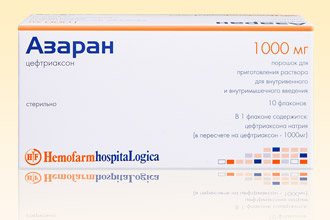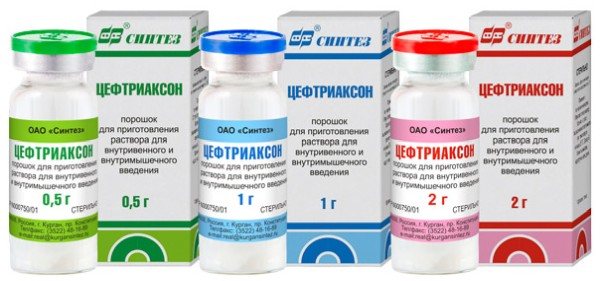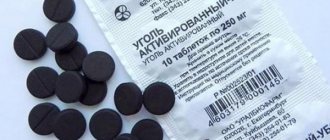Antibiotics are medicines that can destroy microorganisms that have a detrimental effect on the body in a short period of time. There is a third generation of these effective drugs, which include Ceftriaxone, one of the most well-known and frequently used. It is prescribed for the following diseases:
- Gonorrhea;
- Pneumonia;
- Bacterial infections;
- Typhoid fever, etc.
Regardless of the effectiveness of this product, there is a risk of developing allergies from its use; it occurs in children and adults. A negative reaction is explained by intolerance, which does not appear in every person; it is often inherited by close relatives.
In what cases is an allergy to Ceftriaxone observed?
An allergy to a drug almost always occurs unexpectedly, and the reason for such a reaction of the body is considered to be individual intolerance to any components of this drug, which is genetic in nature, that is, inherited. But an allergic reaction can occur not only in a person with individual intolerance; here is a list of the main diseases that can trigger its occurrence:
- HIV infection;
- cytomegalovirus;
- gout;
- mononucleosis.
It is important to understand that if a person is faced with any of these diseases, then there is a high probability of a complete ban on taking all cephalosporin antibiotics. We must not forget about the possibility of developing allergies due to a simple decrease in immunity after antibiotics; experts also note that if mistakes are made related to dosages, it can develop as a side effect.
Ceftriaxone is dangerous for children to the same extent as for adults, because the risk of encountering the problem in question will be approximately the same in any case, it all depends on the immune system, the presence or absence of a genetic predisposition and on dangerous diseases, the list of which was given above.
Also, experts strongly recommend against using this drug in the following cases:
- the patient has serious diseases associated with the liver or kidneys;
- the patient has increased sensitivity to antibiotics that contain cephalosporin or penicillin;
- increased bilirubin in young children;
- first trimester of pregnancy.
Causes of the disease
Antibiotics of the cephalosporin group are prescribed for the following diseases:
- inflammatory diseases of the gastrointestinal tract - peritonitis, cholangitis, cholecystitis;
- pathologies of the genitourinary system - bacterial pyelonephritis, cystitis, gonococcal infection;
- diseases of the respiratory system - pneumonia, sinusitis, tonsillitis;
- bacterial meningitis;
- HIV infection;
- cytomegalovirus infection.
Drugs of this group are also prescribed for the prevention of complications after surgical interventions.
Allergic reactions to Ceftriaxone are possible in adults and children. Persons at risk:
- newborns with hyperbilirubinemia;
- patients with renal and liver failure;
- suffering from stomach ulcers, colitis;
- those who are allergic to antibiotics from the group of cefazolins or penicillins;
- women during the first trimester of pregnancy, while breastfeeding.
An allergic reaction to an antibacterial drug can occur in both an adult and a very young child.
The causes of allergies can be:
- genetic predisposition;
- uncontrolled drug treatment;
- slagging of the body caused by unbalanced nutrition;
- smoking;
- bad ecology;
- prolonged state of stress.
An allergic reaction can develop against the background of decreased immunity after taking antibiotics as a side effect if there is an error in dosage.
Allergy to Ceftriaxone is a type of drug allergy. The body reacts to antibiotic metabolites, increased synthesis of histamine and serotonin occurs, signaling the emergence of a threat. As an immune response, immunoglobulins are produced, which cause a characteristic symptom complex.
An allergic reaction to Ceftriaxone may occur even a few seconds after administration of the medicine or several hours later. This depends on the rate at which the antigen accumulates in the body. Allergies develop against the background of a critical amount of antigen in the blood.
A pathological reaction may occur upon first contact with the drug or develop upon repeated administration of the allergen. Sometimes severe allergic syndrome occurs on the 2-3rd day of taking the medicine.
Symptoms of allergies
Success in treating anything, including an allergic reaction, largely depends on how quickly you identify problems and contact a specialist. For this reason, it is important to know the main symptoms of this problem:
- the appearance of a rash on the skin;
- a significant decrease in immunity or even nausea;
- severe burning and itching sensation;
- general weakness;
- diarrhea;
- constant dizziness;
- problems related to pressure and of a permanent nature;
- fever;
- significant increase in urination;
- Quincke's edema.

If in your case there is a risk of developing an allergic reaction, then it is better not to administer this medication intravenously, as the risk of serious consequences in this case increases. An allergy to Ceftriaxone sometimes has more serious symptoms, for example, with the same intravenous administration, anaphylactic shock can occur within just a few minutes.
Symptoms
Symptoms: nausea, weakness
Each disease is defined by symptoms, after studying which a special treatment course is carried out to promote recovery.
Allergy to Ceftriaxone manifests itself as follows:
- Itching and burning;
- Rash;
- Weakness;
- decreased appetite;
- Nausea;
- Changes in blood clotting for the worse;
- Frequent urination;
- Diarrhea;
- Quincke's edema, accompanied by suffocation;
- Fever;
- High or low blood pressure;
- Dizziness, etc.
When intravenous administration of Ceftriaxone is prescribed, the chance of developing an allergy increases; in severe cases, anaphylactic shock may occur immediately (within 2 minutes after taking the antibiotic).
To prevent even more complications from taking the drug, you should stop taking it altogether.
Diagnostics
Ceftriaxone 25 allergic reactions are extremely varied, but in addition to the manifestations, it is important to pay attention to the diagnostic process. The specialist must check the body’s response to the antibiotic; for this he makes a special test of one of the following types:
All these options must be performed in the sterile conditions of a medical clinic and only by an experienced doctor. The first option for the procedure involves diluting the antibiotic with saline in certain proportions, after which the doctors will release drops of the mixture onto the patient’s skin, where two small scratches will first be made (the skin must be treated with alcohol). Thus, within half an hour it will be possible to determine the likelihood of developing an allergic reaction to this drug.
If there is no reaction to suspected allergies, an intradermal test must be prescribed. The mixture that will be used in this case is no different from the solution that was described earlier; it will simply be injected under the skin. The skin test is very similar to the scratch test, only in this case a scratch is not made. The method helps to determine whether reactions such as itching, burning, as well as redness and much more are observed.
Scarification test
The skin surface is first treated with alcohol, antibiotic drops are applied to the forearm, and small scratches, no more than 10 mm, are made in the area of the drops with injection needles. Drops of saline solution are applied to the other hand. During the procedure, it is necessary to avoid the appearance of blood. The occurrence of a reaction to the drug is monitored for 30 minutes:

- Negative reaction - within 30 minutes there was no redness on either the hand with the antibiotic or the hand with saline solution.
- Weak positive reaction - a small blister appears at the site where the antibiotic test was administered, visible when the skin is pulled.
- A positive reaction is redness and a blister, no more than 10 mm in size.
- A sharply positive reaction is a blister with a diameter of more than 10 mm with redness.
Treatment of drug allergies
Let us immediately mention that treatment of an allergic reaction can only be prescribed by a qualified specialist, and the therapy must be completely carried out under his supervision. Such a manifestation is seriously different from ordinary diseases; it must be eliminated gradually and as carefully as possible. If you do not stop contact with the allergen in time (in this case, continue to use Ceftriaxone), then you will not be able to achieve success, and the problem will become much more serious. After this, therapy will be prescribed; in most situations, one of the following remedies or their equivalent is used:
- Alerzin;
- Polysorb;
- Cetrin.
In severe cases of the disease, hormonal drugs belonging to the group of glucocorticoids can also help, but they can only be prescribed by the decision of a specialist.
Prevention of allergic reactions
It is not enough to overcome an allergic reaction; it is important to follow some other preventive measures that will help prevent its occurrence in the future. It is also necessary to apply preventive measures in situations where you have not encountered this. It is better to do a test once than to treat allergies for a long time. If the test gives a positive result, then taking Ceftriaxone in the future is highly not recommended, because there is a high risk of developing serious complications. Most likely, many other antibiotics will also be prohibited; please discuss this with your doctor.

Under no circumstances should you start self-medicating your allergies without consulting an experienced specialist, because this can end extremely sadly. There are situations where an allergic reaction because of this turned into a more severe form. Let us mention that many people make the mistake of believing that Ceftriaxone is safe when used in the past. In fact, as mentioned earlier, the body may react completely differently in this case.
What to replace

So, what can replace the drug Ceftriaxone if you are allergic to it? After all, its purpose is determined by the need for antibacterial therapy, possibly for health reasons. Many experts recommend using imported analogues of this medication, which are of better quality due to their purified composition, as well as a higher price compared to the domestic drug. But in case of acute reactions and life-threatening symptoms, it is still better to abandon drugs from the cephalosporin group and continue treatment with other drugs that have a similar effect on the body. These may be drugs from a number of aminoglycosides or macrolides.
If you are hypersensitive to Ceftriaxone, you should not replace it with penicillin antibiotics, as cases of cross-allergy are quite common.
Azaran
This medication is an analogue of the drug in question, and also belongs to cephalosporins. Produced in Yugoslavia in the form of powder for injection, it is indicated for use in infectious diseases of the genitourinary system, respiratory organs, as well as blood poisoning, peritonitis, etc. Azaran is of higher quality and rarely causes allergic reactions. It can be prescribed for mild hypersensitivity to Ceftriaxone, but only under the supervision of a physician and after performing a skin test procedure.
Erythromycin
This antibiotic belongs to the macrolides and is indicated for use in infectious and inflammatory processes such as pneumonia, tonsillitis, brucellosis, diphtheria, as well as sexually transmitted diseases. It is not prescribed for liver pathologies, after suffering from jaundice, or in case of hypersensitivity to the active substances. Use with caution in pregnant women, and during lactation it is necessary to interrupt breastfeeding until the end of antibacterial therapy.
Amikacin
The broad-spectrum drug belongs to a number of aminoglycosides and is used in the form of an injection solution. Effective for the following diseases:
- Bronchitis.
- Meningitis.
- Blood poisoning.
- Osteomyelitis.
- Pyelonephritis, cystitis.
- Peritonitis.
- Pneumonia, etc.
Contraindications are high sensitivity to medications of this drug series, renal failure, lactation and pregnancy. Amikacin is used with caution in cases of dehydration, myasthenia gravis, and in elderly and newborn patients. Both intravenous and intramuscular administration are possible.
Ciprofloxacin
This antibiotic from a series of fluoroquinolones is characterized by a wide spectrum of action and effectiveness in the treatment of infectious lesions of the respiratory tract, ENT organs, genitourinary system, gastrointestinal tract, musculoskeletal system, as well as sepsis and peritonitis. The drug cannot be used to treat persons under 18 years of age, as well as during pregnancy and breastfeeding. This antibiotic is prescribed with caution for atherosclerosis, epilepsy, and severe pathologies of the kidneys and liver.
Source msk-med.ru
Alternative drugs
How to replace Ceftriaxone for allergies is the most common question, because the problem for which you were prescribed an antibiotic has not gone away, you just started to be bothered by the symptoms of an allergic reaction. Among the cephalosporins, the following are often prescribed:
In most situations, an allergic reaction is observed to all products in this group, so the use of any of them will pose a health hazard. In such situations, it is recommended to give preference to antibiotics of the penicillin group, for example, Amoxiclav. As for cases where individual intolerance is associated specifically with the components of Ceftriaxone, all the medications that were listed above can be used effectively.
In any case, treatment should be prescribed exclusively by a qualified specialist, so you don’t even need to know how to replace Ceftriaxone in injections, just ask a similar question to your doctor. Follow all his recommendations without neglecting them, then the treatment will be successful.
Source selecthealth.ru
Ceftriaxone is a third-generation antibiotic that belongs to the broad-spectrum antimicrobials. It is prescribed for:
- Cytomegalovirus.
- Salmonellosis.
- Pneumonia.
- Diseases of the genitourinary system (for example, pyelonephritis)
- Gonorrhea.
These diseases are indications for the use of a cephalosporin antibiotic. However, the body does not always behave as doctors would like.

Purpose and therapeutic possibilities of Ceftriaxone
Treatment of complex infectious lesions is based on the use of the most effective drugs. The drug Ceftriaxone from the group of cephalosporins is recognized as one of the best drugs for the treatment of diseases caused by gram-positive and gram-negative bacteria.

A wide spectrum of action is a distinctive feature of the pharmacological properties of Ceftriaxone.
The use of the drug is appropriate for bacterial infections of organs:
- Gastrointestinal tract;
- respiratory tract - pneumonia, abscesses, purulent processes in the pleural cavity;
- urogenital zone - pyelonephritis, prostatitis, gonorrhea;
- musculoskeletal system - joints, cartilage;
- abdominal cavity - peritonitis;
- laryngootorhinology - throat, nasopharynx and ears.
In addition, the use of Ceftriaxone is appropriate for bacterial meningitis, infected wounds and burns, salmonellosis or Lyme disease, and postoperative infections.
In most cases, treatment with Ceftriaxone is successful, without complications or adverse reactions. But if you are individually intolerant to the components of the drug, signs of an allergy to Ceftriaxone may appear. In such situations, you should stop further use of the drug and seek help from a doctor.
What causes allergies?
Antibiotics of the cephalosporin and penicillin groups act like serial killers - they kill everyone indiscriminately. The body's natural defense system reacts to the killer as a harmful substance and begins to block it. As a result, immune complexes are formed, which, when the drug is administered, tend to neutralize it. Therefore, the allergy often manifests itself immediately upon administration, only sometimes within a few hours.
In addition, malfunctions in the immune system force it to produce immunoglobulins when it is not needed at all. Such failures include: HIV, lymphocytic leukemia, mononucleosis.
Alternative to Ceftriaxone
Ceftriaxone analogue
Many drugs are being replaced by less expensive, more effective ones or those whose spectrum of action is broader.
Ceftriaxone belongs to the group of cephalosporins; in addition to it, it also includes analogues such as:
- Cefazolin;
- Oframax;
- Movigip;
- Cefpir;
- Triaxone;
- Cephalexi;
- Longatsev and the like.
If intolerance or hypersensitivity to the components of Ceftriaxone is detected, then the above drugs will be a worthy alternative, as they have similar antibiotic properties.
If there is a negative reaction to antibiotics from the cephalosporin series, then medications that are in the penicillin group will come to the rescue, these include Amoxiclav
There is a poor combination of Ceftriaxone with antibacterial drugs, the constituent components of which are calcium; use in conjunction with non-steroidal drugs that fight various types of inflammation is not recommended. If precautions are not followed, the chances of bleeding increase.
Doctor
Clinic depending on age
An adult will experience symptoms such as:
- Changes in the skin - rash, burning, itching at the injection site. Sometimes it can itch in completely different places.
- Blood composition disorders - eosinophilia, hypothrombonemia (clotting is impaired). Such signs can only be seen in a blood test.
- Interstitial nephritis – problems with the genitourinary system. Manifested by nausea, dizziness, frequent urination, and lower back pain.
- Quincke's edema - the mucous membranes of the nose and larynx swell, resulting in suffocation.
- Fever.

The child will have similar symptoms, but the reaction may be more violent, even immediate:
- Anaphylactic shock. In this case, the nurse needs to have an anti-shock kit on hand: adrenaline, prednisolone, Dopamine, Epinephrine, Eufillin.
- Quincke's edema, which causes difficulty breathing, whistling when inhaling, sore throat. Due to the difficulty of inhaling, the heart rate increases.
- Skin manifestations - hives all over the body or the injection site.
- Numbness of the limbs.
Here, frightened patients begin to panic with every ailment. But Ceftriaxone is a medicine with the same side effects as the others. The most common side effects are: nausea, malaise, diarrhea, vomiting, stomatitis, phlebitis. The latter can be avoided by changing the vein (with intravenous injections) and reducing the time of drug administration.
How to distinguish a normal reaction of the body from an allergy?
Side effects often occur during treatment with Ceftriaxone. These include the following symptoms:
- dizziness or headache;
- nausea;
- vomit;
- diarrhea;
- stomatitis;
- glossitis (inflammation of the tongue);
- oliguria (decreased amount of urine excreted by the kidneys);
- phlebitis (inflammation of the vessel wall) with long-term intravenous administration.
Although these symptoms are not signs of an allergy, if some of them occur, it may be necessary to discontinue the drug or adjust its dosage. In almost all cases, when Ceftriaxone is administered, the following local reactions may occur:
- pain along the vein during intravenous administration;
- pain and burning at the injection site with an intramuscular injection.
These symptoms cannot be a reason to discontinue the drug. However, if they are poorly tolerated by the patient, especially when the drug is administered intramuscularly, dilution of the antibiotic with local anesthetics (novocaine, lidocaine) may be prescribed.
How to avoid and how to treat?
You can prevent such a nuisance by testing for sensitivity to antibiotics. To do this, the nurse dilutes the antibiotic 1:10 and draws it into a syringe without a needle. A few drops are dripped onto the middle third of the forearm, and then wait a few minutes. If the patient's arm turns red, the drug should not be administered. If not, you can move on.
The next step is to scratch the skin with a scarifier, after which a few drops from a syringe are dripped onto it. If there is no result, then the last test is carried out. The nurse draws 0.1 ml of Ceftriaxone into a syringe and injects it intradermally. Interval – 20 minutes. If the result is negative, there will be no allergies. It is especially important to carry out this test for children of preschool and primary school age.
Useful video
Watch the video about the use of Ceftriaxone:
Similar articles
- Ceftriaxone and alcohol: what is the compatibility...
Is it worth combining Ceftriaxone with alcohol? How compatible are beer, wine, vodka and antibiotics? How long does it take for Ceftriaxone to be removed from the body, when can you drink it after injections? Read more - Ciprofloxacin and Ceftriaxone: similarities, they are one and the same...
When are the drugs Ceprofloxacin and Ceftriaxone needed? This is one and the same thing, what is the difference between them in terms of indications, contraindications, effect. What is best to take and when. Read more
- Ceftriaxone for angina: how to use for adults...
How to properly use Ceftriaxone for tonsillitis, if prescribed for adults or children with purulent tonsillitis, tonsillitis. Will it really help, why doesn't it help? How to dilute with Lidocaine, is it possible to gargle. Read more
- Treatment of syphilis with Ceftriaxone: scheme, how to inject...
How is syphilis treated with Ceftriaxone? What regimen will the doctor prescribe? How to give injections correctly, their dosage. Is it possible to cure syphilis with Ceftriaxone, is recefin better than penicillin? Read more
Allergy prevention
Thus, the problem can be identified in advance by fulfilling several conditions. The first thing is not to be too lazy to conduct a test within 24 hours. Be sure to leave 20 minutes at each stage for the reaction to occur. It is important for the patient to report any suspicious ailments during the test.
Secondly, it is necessary to mention allergies to medications, if any, and do not forget to mention your parents’ reactions to antibiotics - genetics plays a key role in this issue. People with diseases of the immune system, gout, and HIV are wary of antimicrobial drugs. With a correctly collected anamnesis, it will be easier to identify the causes, and it is better to completely prevent an emergency condition.
Third, never self-medicate . If the situation is familiar, the disease has already occurred, the prescription has been preserved - still, without a doctor, you should not prescribe anything for yourself. An allergy may not develop immediately.
Source allergiyas.ru
Risk factors
People with allergies to penicillin and medications are at risk. It can often occur in pregnant women and young children. The drug should be prescribed with caution in the elderly. It is worth considering that the reaction may resemble a side effect. If suspicious manifestations occur, stop taking the medication and inform your doctor.
Allergy to antibiotics is a serious problem
Causes of an allergic reaction
Allergies to antibiotics are very common. In this case, the immune system perceives the drug metabolites as harmful cells. This will be accompanied by the appearance of symptoms of pathology.
In most cases, allergies are easily confused with hypersensitivity to certain components. Signs also resemble drug intolerance. A doctor will help determine the pathology using diagnostic methods.
The main reasons for the reaction include:
- presence of drug allergies;
- hereditary predisposition;
- chronic diseases;
- congenital pathologies;
- intolerance to penicillin.
The true cause can only be known after diagnosis. Before prescribing such a drug to a patient, the doctor must test for the presence of an allergic reaction.











